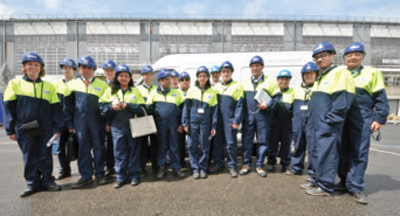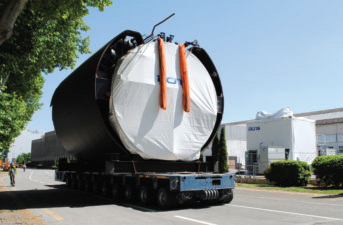|
 Conventional
submarines can operate under water only as long
as there is charge in their batteries. At slow
speed, the duration a submarine can stay underwater
can be a day or two, but if the submarine moves
at high speed to escape after an attack or go
in for an attack, it will run out of battery power
swiftly. For recharging, it will need to surface
or come to a depth from where it can push a funnel
pipe – snorkel – to suck air. Conventional
submarines can operate under water only as long
as there is charge in their batteries. At slow
speed, the duration a submarine can stay underwater
can be a day or two, but if the submarine moves
at high speed to escape after an attack or go
in for an attack, it will run out of battery power
swiftly. For recharging, it will need to surface
or come to a depth from where it can push a funnel
pipe – snorkel – to suck air.
The name snorkel refers to an air intake just
above the sea surface which enables a submerged
submarine to draw air to run a diesel engine and
to access atmospheric oxygen. Only the air intake
pipe is visible while the submarine hull is invisible
below the sea surface.
But the snorkel is susceptible of being located
from ships, and particularly aircraft and satellites,
thereby giving the position of the submarine.
The answer to this vulnerability of conventional
submarines was the induction of nuclear propelled
submarines which did not have to surface for months
on end, but nuclear submarines are very expensive
to build and maintain. Only five nations in the
world, which are also nuclear weapon states, have
the capability to build and operate nuclear submarines.
When India’s own home built submarine INS Airhant,
presently undergoing harbour acceptance trials
(HATS) at Vishakapatnam is commissioned, India
will join this club as the sixth nation.
Brazil has a plan to build nuclear submarines
with French ship and nuclear submarine builder
DCNS’s help. Forty Brazilian engineers, architects
and naval officers are undergoing training in
France at the Centre Indret at Nantes to ultimately
construct nuclear submarines in Brazil. Other
submarine operating nations are looking to non-nuclear
technology to enable submarines to stay under
water for prolonged operations without surfacing.
DCNS, which supplied Agosta submarines to Pakistan
and is building Indian Navy’s Scorpene submarines,
invited Indian and some other foreign journalists
to witness its facilities, including the construction
of AIP systems. High-strength steel containers
for Areva’s nuclear power plants for France and
China were also being built there.
There was one AIP unit there, nearly built, possibly
for a Pakistani Agosta.
 AIP
is a breakthrough technology for conventional
submarines, enabling them to remain underwater
three or four times a vessel’s standard capacity.
It is a propulsion package technology given the
generic name of Air Independent Propulsion. AIP
is a breakthrough technology for conventional
submarines, enabling them to remain underwater
three or four times a vessel’s standard capacity.
It is a propulsion package technology given the
generic name of Air Independent Propulsion.
The Indian Navy is working on a proposal to induct
the AIP for the last two or three of its six Scorpene
submarines being built by Mazagon Dock Ltd. (MDL)
while the next lot of six more submarines will
all be equipped with it.
Notably, a submarine is about stealth. It is
a weapons platform not visible to the naked eye.
AIP significantly improves stealth because it
enables a submarine to generate electricity for
services and battery charging and propulsion while
completely submerged.
AIP systems are auxiliary, like a smaller hull
inserted in the main body. They generate electricity,
powering a submarine’s to operate and also generate
oxygen, lighting and amenities for crew. Accordingly,
they enable conventional diesel-electric submarines
to remain submerged for two to three weeks at
a time. Without AIP, diesel-electric submarines
have to come up to snorkeling depths just below
the surface or surface at shorter intervals so
that the diesel engines can recharge their batteries.
This significantly increases the risk of detection.
A submarine’s diesel engines can only be started
once the snorkel has cleared the surface to take
in oxygen in the fresh air. Snorkeling depth is
about the same as periscope depth. AIP significantly
improves stealth because it enables a submarine
to generate electricity for services and battery
charging and propulsion while completely submerged.
The development of AIP has taken time, and it
was the Spanish scientist Narcís Monturiol i Estarriol
who first thought of it in 1867. After that the
Germans, British and Soviets worked on it. The
latest French system, MESMA (Module d’Energie
Sous- Marine Autonome) or Autonomous Underwater
Energy Module, can be fitted on both the Agosta
90B and Scorpene class boats. Energy is produced
onboard by burning ethanol and stored oxygen.
MESMA, or similar systems from some other countries,
enable submarines to stay submerged for around
three weeks. Their development has led to a paradigm
shift in submarine warfare. In fact, this technology
comes under the umbrella of the generic term,
Revolution in Military Affairs (RMA), which has
led to quantum jumps in the technologies and capabilities
of platforms and weapon systems, and accordingly
their deployment in conflicts and war.
One of the major challenges at sea is the identification
of targets: friend or foe.
The advances made in detection of electronic
transmissions (EW) and photography can be put
through finger printing algorithms and even small
contacts of submarine periscopes or a snorkel
can be detected and identified. Therefore the
paradigm shift in the auxiliary propulsion system
of modern submarines with the development of AIP
has made submarines even more versatile. They
can approach enemy coasts undetected like nuclear
submarines and conduct appropriate missile attacks.
MESMA can be retrofitted by fitting an additional
hull section, called a plug, in the submarines.
The Pakistan Navy has already fitted MESMAs on
two of its Agosta 90B Boats. The system was built
and tested in France and then transported to Karachi.
Notably, as MESMA being an auxiliary system does
not replace the main power units, or atmospheric-dependent
propulsion. Nor does it give much speed to a boat
but it does enable it to stay underwater for longer
durations and move away after an attack to safer
distances. A submarine is a sitting duck if detected,
and aircraft like the Boeing P8-I which India
is acquiring, are specifically designed to detect
and hunt down submarines.
India’s Defence Research and Development Organisation
(DRDO) is also now working on developing indigenous
AIP technology at the Naval Material Research
Laboratory (NMRL), Ambernath, by 2015.
Meanwhile, the Government has set aside $ 9
to 10 billion for six new generation AIP-equipped
submarines under what is designated Project 75-I.
|